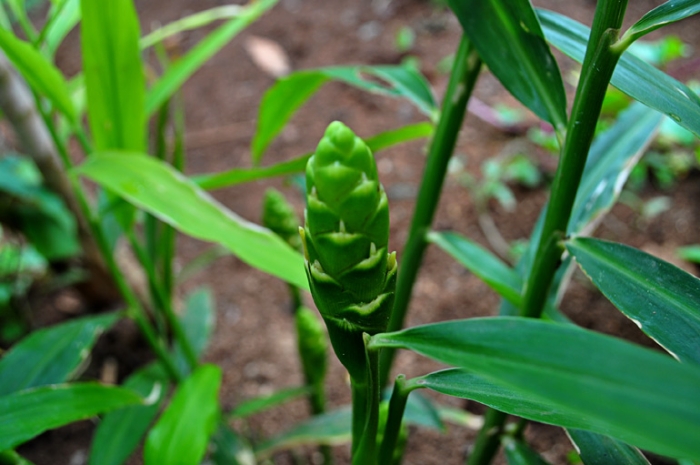Garden Ginger
(Zingiber officinale)
Garden Ginger (Zingiber officinale)
/
/

Venkatx5
CC BY-SA 3.0
Image By:
Venkatx5
Recorded By:
Copyright:
CC BY-SA 3.0
Copyright Notice:
Photo by: Venkatx5 | License Type: CC BY-SA 3.0 | License URL: https://creativecommons.org/licenses/by-sa/3.0 | Uploader: Venkatx5 | Publisher: Wikimedia Commons | Title: Ginger_Plant_vs.jpg |












Estimated Native Range
Summary
Zingiber officinale, commonly known as Garden Ginger, is a perennial herb that is deciduous in cooler climates and evergreen where winters are mild. It is native to the understory of tropical rainforests in the Indian subcontinent and Southeast Asia. It typically grows to about one meter tall with narrow, glossy green leaf blades. The inflorescences are showy, bearing pale yellow flowers with purple edges, and arise directly from the rhizome on separate shoots. Flowering usually occurs in late summer.
Garden Ginger is valued for its aromatic rhizomes, which are widely used as a spice in culinary dishes and have medicinal properties. Its ornamental qualities include the attractive foliage and unusual flowers, making it suitable for tropical-themed gardens. It is also grown commercially for the spice trade. In cultivation, Garden Ginger thrives in part shade, requiring medium to high amounts of water and well-draining soil rich in organic matter. It is relatively easy to maintain but can be susceptible to root rot if overwatered or planted in poorly draining soils. While not typically invasive, it can spread in optimal conditions and may require control measures to keep it within bounds.CC BY-SA 4.0
Garden Ginger is valued for its aromatic rhizomes, which are widely used as a spice in culinary dishes and have medicinal properties. Its ornamental qualities include the attractive foliage and unusual flowers, making it suitable for tropical-themed gardens. It is also grown commercially for the spice trade. In cultivation, Garden Ginger thrives in part shade, requiring medium to high amounts of water and well-draining soil rich in organic matter. It is relatively easy to maintain but can be susceptible to root rot if overwatered or planted in poorly draining soils. While not typically invasive, it can spread in optimal conditions and may require control measures to keep it within bounds.CC BY-SA 4.0
Plant Description
- Plant Type: Herb
- Height: 2-4 feet
- Width: 2-4 feet
- Growth Rate: Rapid
- Flower Color: N/A
- Flowering Season: Fall
- Leaf Retention: Deciduous
Growth Requirements
- Sun: Part Shade
- Water: Medium, High
- Drainage: Medium, Fast
Common Uses
Border Plant, Edible*Disclaimer: Easyscape's listed plant edibility is for informational use. Always verify the safety and proper identification of any plant before consumption., Potted Plant
Natural Habitat
Understory of tropical rainforests in the Indian subcontinent and Southeast Asia
Other Names
Common Names: Ginger, Ingwer, Jengibre, Gingembre, Zenzero, Gengibre, Ingefära, 薑, Saenggang, Shoga
Scientific Names: , Zingiber officinale, Amomum angustifolium, Zingiber aromaticum, Amomum zingiber, Curcuma longifolia, Zingiber officinale var. rubrum, Zingiber missionis, Amomum zinziba, Zingiber cholmondeleyi
GBIF Accepted Name: Zingiber officinale Roscoe